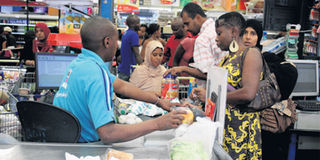Firms target Africa’s fast-growing middle class with fresh products

Shoppers at a supermarket in Nairobi. With more money in the pocket, the typical African middle-class consumer places higher demands on manufacturers. Photo/FILE
What you need to know:
- With more money in the pocket, consumers are willing to pay an extra coin for higher quality products. Brand consciousness also ranks high.
Consumer goods manufacturers in Africa are reworking their strategies as they seek to capture the needs of a fast-growing middle-class.
In an interview with Smart Company last week, Unilever East and South Africa managing director Yaw Nsarkoh said the company is investing in innovations and new product delivery channels targeted at a rising middle-class with increasingly sophisticated needs.
“We see new need clusters developing in the market. As incomes of people living in the region grow, market segmentation will begin to emerge. We have to listen to these consumers,” said Mr Nsarkoh.
Unilever’s rival, Proctor&Gamble, is also betting on Africa. On a trip to South Africa last month, P&G’s global vice-chairman, Mr Dimitri Panayotopoulos, announced the investment of Sh14.28 billion in a new manufacturing hub in the country. The plant, to be completed by 2016, is expected to cater to markets in East and South Africa.
Growing stable markets
“We are in Africa because of the size. It’s about a billion people. That’s the size of China and India for example, just under, and the population is growing; the economies are getting more and more stable, so huge opportunities are there,” said Mr Panayotopoulos as quoted by CNN.
Construction of the hub in South Africa may, however, disadvantage P&G in the East African market, in comparison with Unilever whose regional manufacturing centre is in Nairobi. The Kenya plant, located in Industrial Area, manufactures goods that account for 90 per cent of Unilever East and South Africa’s (ESA) total turnover.
According to the African Development Bank (AfDB), between 1970 and 2010, Africa’s middle-class tripled to hit 313 million people, or more than 34 per cent of the continent’s population.
In an October 2012 report, McKinsey Company projected that the value of Africa’s consumer market will grow to Sh33.6 trillion ($400 billion) by 2020, driven mainly by growth in the continent’s middle-class.
This growth in the middle-class has profound implications for both the retail and fast moving consumer good sectors in Kenya. With a larger discretionary income, the tastes of this new group are changing as are their shopping patterns.
Over the past two decades, Kenya’s fast moving consumer goods segment has been driven by the “kadogo economy”, characterised by small packages of goods priced as little as Sh5, targeted at the low-end of the market and distributed mostly by kiosks.
But the growth of Kenya’s middle-class has been proportionately matched by the rise of the hyper-retailers. Investors are putting up malls in nearly every neighbourhood. Companies like Unilever, therefore, need to increase focus on this part of their distribution network to reach the middle-class.
The AfDB also notes that income inequity is still stark in Africa. So, although these firms may have to turn their attention towards the hyper-malls, they can ill afford to neglect the kadogo customer.
“Our strategy is usually expressed as straddling the entire pyramid. We will not box ourselves into the bottom end or the top end of the market. The Kadogo economy continues to be relevant,” noted Mr Nsarkoh.
With more money in the pocket, consumers are willing to pay an extra coin for higher quality products. Brand consciousness also ranks high.
In the past, as McKinsey notes, multinationals were often able to get away with focusing purely on the price-point in their African markets while neglecting the quality of the products. This will no longer be possible.
As the African consumer rises, so will the African working woman. Changing socio-economic dynamics have seen more women on the continent find their way into the workforce. These women will drive Africa’s consumption.
The International Finance Corporation (IFC), in a research note last year, estimated that global consumer spending by women would hit $28 trillion next year, up from the $20 trillion recorded in 2009.
Companies like Unilever are now finding themselves in a situation whereby they have to create and market products to a working mother and wife.
She has less time to spend washing clothes or cooking and this is reflected in the nature of products produced — instant meals and short-cycle detergents find a new market.
Unilever and P&G are going neck-and-neck in the local consumer goods market, with data collected by Consumer Insight Africa (CIA) indicating that P&G’s brand, Ariel, is now the market leader in the detergents segment.
However, CIA also claims that once two of Unilever’s detergent brands, Sunlight and Omo, are taken into consideration, the firm still controls the lion’s share of the local business.
Both multinationals are also facing a challenge from local manufacturers such as Bidco and Kapa Oil, who have over the past decade invested heavily in manufacturing capacities and are now taking the fight to the advertising arena.



